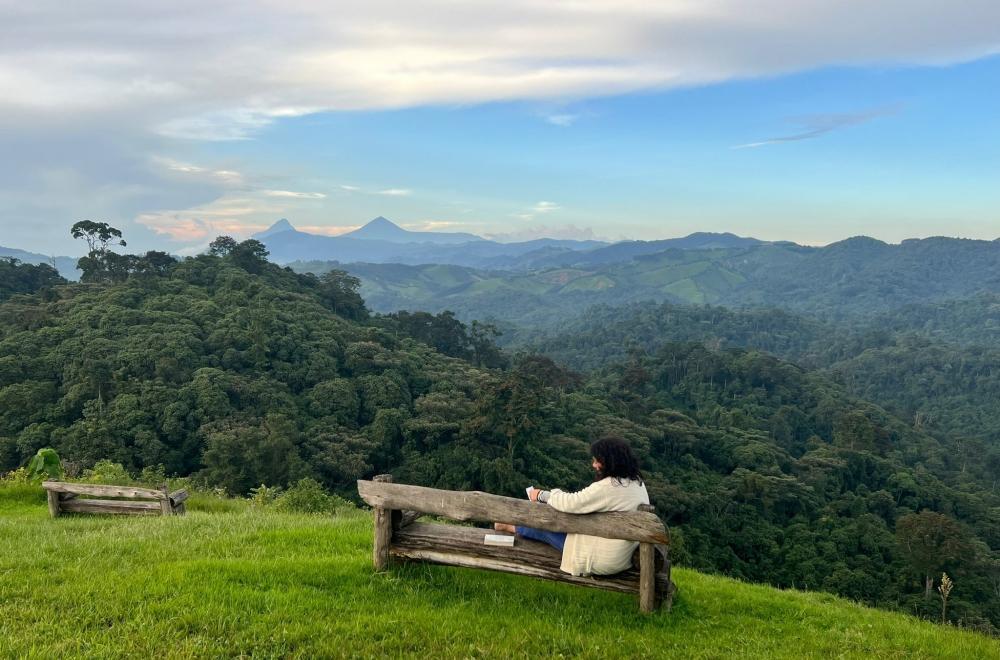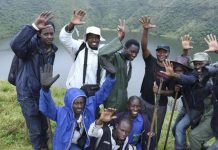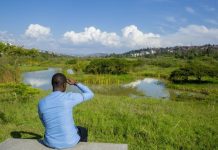Africa-Press – Rwanda. Since the opening of Gishwati–Mukura National Park tourism activities in 2019/2020, communities surrounding the park have received approximately Rwf 2 billion, equivalent to 10 per cent of the tourism revenue generated, to support development projects that improve livelihoods and promote conservation.
According to Gishwati-Mukura Chief Park Warden, Anaclet Budahera, the number of chimpanzees has increased from 13 in 2007 to 40 in 2025 after the park’s restoration.
The chimpanzee is listed on the IUCN Red List as an endangered species.
The chimpanzees in Gishwati-Mukura were on the verge of extinction over 10 years ago due to massive encroachment and degradation of the forest.
The second phase of the park’s rehabilitation allocated at least $65,000 to support women beekeepers’ development projects, enhancing livelihoods and promoting conservation. Courtesy Photo
The progress was shared as Rwanda marks the International Day for Biosphere Reserves, celebrating regions where nature and communities coexist in harmony, on November 4 around Gishwati-Mukura National Park.
These reserves serve as living laboratories that demonstrate practical models of sustainable development, environmental conservation, and community well-being.
In 2020, the Gishwati-Mukura landscape in Rwanda’s Western Province was named among the World Network of Biosphere Reserves by the United Nations Educational, Scientific and Cultural Organization (UNESCO).
Biosphere reserves help to better understand and manage changes and interactions between social and ecological systems, as well as protect biodiversity. They also provide local solutions to global challenges and promote innovations in the conservation and sustainable use of biodiversity.
In 2016, Gishwati-Mukura National Park was gazetted as the country’s fourth national park. In 2019, the Rwanda Development Board took over its management.
The park is made up of two separate forests – the larger Mukura and the smaller Gishwati – which are located within the landscape.
The forests sit on the ridge which divides the Congo and Nile water catchment areas, along the biodiverse Albertine Rift.
Gishwati-Mukura National Park opened for visitors on 1 December 2020.
“The tourists are attracted by different biodiversity species including chimpanzees. There were 13 chimpanzees in 2007. The number increased to 19 chimpanzees in 2011 and 40 in 2025 after the park’s restoration. Golden monkeys, duikers and birds also increased,” he said.
About Rwf2 billion, which is 10 per cent of tourism revenues, has so far been spent on community development activities over the past six fiscal years from 2019/20 to 2024/25.
Budahera said Rwf1.3 billion benefitted communities around the park in Rutsiro District, while Rwf655.3 million benefitted communities in Ngororero District.
The revenue helped in constructing houses for vulnerable communities, water supply projects, distribution of energy-saving stoves, upgrading of health posts and centres, tailoring, beekeeping and handicraft projects, classrooms and market construction, as well as road and bridge rehabilitation, among others.
Budahera said six beekeeping cooperatives comprising 510 members (240 women) have been established and provided with about Rwf100 million.
Davtive Kayitesi, Mayor of Rutsiro District, said modern beekeeping tools and materials were distributed to support and empower women beekeepers.
A tourist enjoys reading and relaxing at Gishwati-Mukura National Park, Rwanda’s fourth national park, established in 2016. Courtesy Photo
Dominique Mvunabandi, Director of the Science and Technology Unit in the Rwanda National Commission for UNESCO (CNRU), said that the Women for Bees Programme by UNESCO and Guerlain is empowering Rwandan women, focusing on beekeeping and biodiversity conservation.
“At least $65,000 funding benefitted the women beekeepers in the second phase. Three cooperatives with 36 women benefited from the programme,” he said.
“Our honey production has drastically increased thanks to improved beehives. Previously, we could harvest between 200 and 300 kilogrammes of honey from 10 traditional beehives. Now, we harvest 750 kilogrammes per season from 10 improved beehives,” said Emilienne Mukasine, the representative of 11 women beekeepers in the COVEB cooperative, in Mushonyi Sector, Rutsiro District.
Biodiversity assessment in Gishwati-Mukura Park
Mvunabandi said that UNESCO also helped in carrying out biodiversity assessments in Mukura and Gishwati, as well as documenting indigenous knowledge among communities around Gishwati Forest.
Such biodiversity attracts bees and tourists.
The biodiversity assessment in Mukura Forest Reserve, which was published in April 2025, surveyed plants, birds, mammals, amphibians, reptiles, terrestrial arthropods, butterflies, water macroinvertebrates, and diatoms across 20 sites.
Results recorded 1,523 individuals of water macroinvertebrates and 25 diatom species, highlighting minimal anthropogenic disturbance of water in Mukura Forest.
Results also indicated a total of 4,044 arthropods, including 24 butterfly species.
Avian surveys documented 124 species, with 12 Albertine Rift endemics and the critically endangered Hooded Vulture.
Amphibians and reptiles yielded 12 and 5 species, respectively. Identified small mammals included 12 species, with three new records for Mukura.
The floristic assessment identified 255 species, with two newly recorded.
“These findings underscore the significance of Mukura for biodiversity and emphasise the need for further research and conservation efforts,” the study recommends.
A study on indigenous knowledge among communities around Gishwati Forest suggested guidelines to incorporate indigenous knowledge into conservation.
Guidelines for integrating indigenous knowledge into conservation call for stronger collaboration between the Rwanda Development Board (RDB), conservation partners, and local communities.
They emphasise building the knowledge and capacity of communities living near protected areas to enable their active participation in conservation.
Organising residents into cooperatives is encouraged to enhance coordination and collective action.
Traditional healers are to be supported in establishing home-based gardens for medicinal plants, helping preserve both biodiversity and cultural heritage.
The plan also proposes creating a sustainable community knowledge base to document and share indigenous ecological practices.
Finally, improving the management of human–wildlife conflicts is key to promoting peaceful coexistence between people and wildlife.
Restoration of Gishwati-Mukura Forest in Western Province started in 2014.
Gishwati-Mukura is made up of two forests – Gishwati and Mukura – and was established as a legally protected area by approving it as the country’s fourth national park in 2016.
For More News And Analysis About Rwanda Follow Africa-Press








